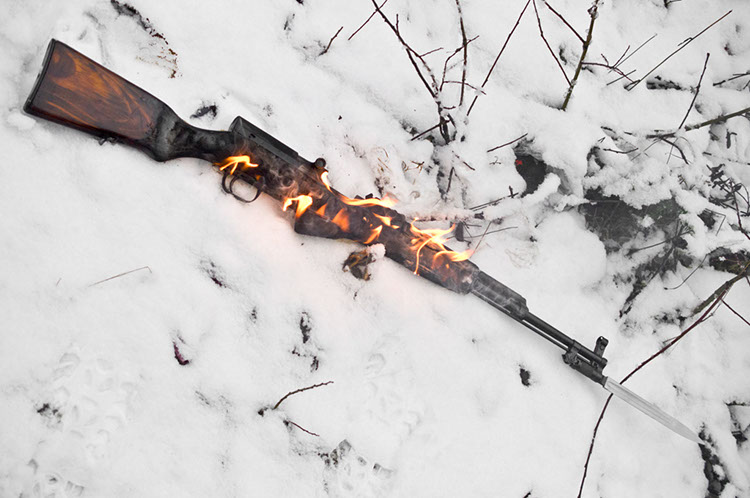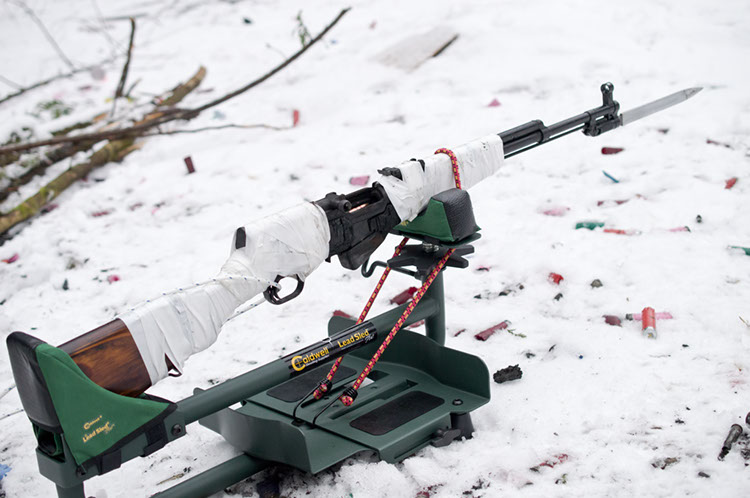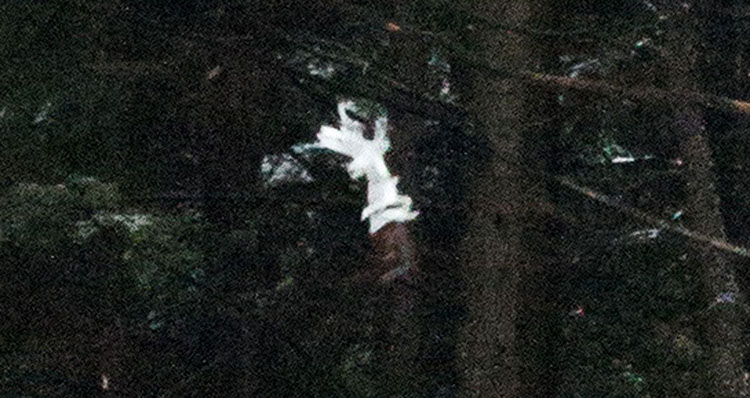
In 1943 a Soviet gun designer by the name of Sergei Gavrilovich Simonov designed a relatively small and lightweight carbine chambered in the then-new 7.62x39mm round. Using a dramatically scaled-down version of the same piston-driven action as Simonov utilized in his PTRS-41 anti-tank rifle (a gun that came chambered in the Soviet 14.5x114mm cartridge that surpasses even the .50 BMG in terms of power) the SKS was earmarked as a second-string rifle by the Soviet brass; a sort of old-world milled and forged rifle that could quickly fill in for the revolutionary AK-47, should Kalashnikov’s unproven manufacturing techniques end up producing a less than reliable front line firearm. Obviously, that wasn’t the case, and the SKS was doomed to play second-fiddle to the more popular AK.
 But that doesn’t mean production of the SKS rifle stopped. On the contrary, in no less than three Russian factories, multiple Chinese factories, and seven other factories in countries ranging from Albania to North Korea, manufacturing of the SKS continued at a pace best defined as ridiculous. Although firm numbers are hard to pin down, there is no doubt that the total number of SKS rifles produced is a figure that stretches well into the tens of millions, and is still growing due to their ongoing production in China.
But that doesn’t mean production of the SKS rifle stopped. On the contrary, in no less than three Russian factories, multiple Chinese factories, and seven other factories in countries ranging from Albania to North Korea, manufacturing of the SKS continued at a pace best defined as ridiculous. Although firm numbers are hard to pin down, there is no doubt that the total number of SKS rifles produced is a figure that stretches well into the tens of millions, and is still growing due to their ongoing production in China.
Furthermore, being of the last autoloading military rifles incapable of fully-automatic fire, the SKS has become immensely popular amongst civilian markets around the world. And let’s be honest, while the SKS’ attributes of reliability and a popular chambering play a role, the chief factor that has given rise to the SKS’ popularity is the price tag attached. It is the absolute cheapest semi-automatic centerfire rifle on the market with prices typically coming in at $200 or better. Some variation in price is expected for particular models, manufacturers, and countries of origin.
So what is an SKS? It’s a gas-operated, piston-driven semi-automatic rifle that incorporates a 10-round blind magazine typically fed by stripper clips. Of course, here in Canada, those magazines are pinned to just five rounds. The stock is comprised of either some form of wood or is of a laminate construction. The barrels are typically chrome-lined (Yugoslavian SKS’ being the notable exception to that rule) and the receivers are milled and forged steel, with stainless steel bolt carriers and milled top covers. The magazine itself is a ridiculously overbuilt stamping with a milled follower and a bolt-hold open feature that conveniently allows for fast recharging via the stripper-clip guide milled into the bolt carrier. Add in the increased power offered by the slightly longer barrel, the added benefit of the slightly longer sight radius, and the downright brilliant trigger guard safety and it’s entirely possible to make the argument for the SKS being superior even to the AK-47 that replaced it.
So we thought we should probably go buy one just to see how tough they really are.
Step 1: Cosmoline isn’t a lubricant.

What it isn’t, however, is a lubricant. Sure, it kept the gun bores on World War II warships from rusting and ensured an entire invasion force’s hardware didn’t corrode on the beaches of Normady, but it is not a lubricant. We cannot stress that enough. Yes, it feels slick in the hands, but it possesses none of the other properties required of an even mediocre gun oil. First off, cosmoline does not prevent the buildup of carbon on metal nor does it even attempt to flow carbon away from a friction surface. Furthermore, it cannot stand up to the pressures nor temperatures seen by firearm lubricants, and either burns off or flows away from heat. And what generates heat? Pressure and friction. Precisely the sort of situations when you want lubricant.
But you know how it is when you get a new gun. Logic, reason, and patience all go out the window in a flurry of activity all centered around making your new gun go bang for the first time. So, we loaded our brand-new(ish) SKS into the truck with a spam can of ammunition and headed for the hills with nothing more than a cursory glance down the bore.

So, imagine our surprise when the rifle burped out no less than 80 rounds before encountering its first hiccup. Keeping in mind that we literally pull this SKS out of the cosmoline-filled bag it’d lived in for at least a few decades and started shooting, we were already impressed, especially after all the horror stories we’d heard about cosmoline causing firing pins to bind up and the like. In fact, we were so impressed by the rifle’s performance with no preparation that when the bolt closed on an empty chamber with rounds in the magazine, we were tempted to call it human error. Perhaps a round not quite seated properly in the magazine or the like. However, just three rounds later, the rifle encountered a misfeed in which an unfired round was stripped from the magazine and essentially stovepiped.
However, we didn’t feel that a mere 83 rounds was an adequate test of cosmoline’s lubricity, or lack thereof. So we cleared the malfunction and kept pounding away. Interestingly, for the remainder of our 150 round cosmoline rest, the gun ran without missing a beat. This leads us to believe that perhaps our two failures were related; perhaps a single blob of cosmoline causing the magazine follower to tilt or can’t slightly or perhaps even simply causing the rounds to bind within the magazine. Whatever the reason, both failures were rooted in the rifle’s ability to feed from the magazine, and occurred within three rounds of each other. It seems somewhat coincidental over the span of 150 rounds that two rounds should fail to feed in such rapid order.
Test 2: Fire is an excellent cosmoline remover.

So we built a nice big roaring fire about 2 feet tall, and we hucked our SKS into it. Now, this sounds crazy, but bear with us… actually, don’t, it is a really stupid idea.
But anything worth doing is worth doing right, so we stuck with it, and used the extended bayonet to rotate it for even cooking on both sides. And frankly, although we knew cosmoline was flammable, we were legitimately surprised at the complete immolation of the rifle the second it touched flame. We tried to get the action and gas system right into the hottest portion of the fire, while keeping the buttstock out of the flames, as we wanted to get as much heat into the action as possible to test the temper of the various springs and forged bits.


In order to cool the action sufficiently, and just to be extra vindictive, we actually buried the action in snow and tamped it down to really pack it in there. Impressively, the action had absorbed so much heat from the fire that it remained too hot to touch after 20 minutes packed in the snow, and even after 30 minutes was still warm to the touch. In order to continue the test, we then slid the rear portion of the stock back on, and swaddled it the loving embrace of about half a roll of hockey tape. Because it was what we had on hand.
But hey, we certainly took care of that cosmoline problem.
Test 3: Firing the rifle dry. Extremely dry.

And 50 rounds later the thing was showing no signs of slowing down. With an action caked in carbon, ash, and soot the thing was unfazed. Hell, we even realized there was a bit of hockey tape actually binding on the bolt, but we only discovered that when the bolt literally started chewing through it. Obviously demonstrating the benefits of the gun’s piston-driven design, it also illustrated that the SKS’ recoil spring is quite stout, and that the combination of the two can push the bolt back and forth under even the worst conditions. We also felt that the shape of the 7.62 round is owed at least some of the credit. Due to its small size and tapered sides, it not only requires less fore and aft movement from the bolt, but also feeds out of the magazine and into the chamber more readily than a smaller and skinnier straight-walled cartridge.

Test 4: An all-natural food-grade Canadian lubricant.
Maple syrup. We’ve all tasted it, and if you’ve tasted it, then you’ve also gotten it on your hands. That’s how maple syrup works. And it’s always the same two stories. You grab the syrup pot at the local IHOP and realize the handle is coated in syrup. Or you’re putting some on your pancakes or waffles, thinking about how great it’ll taste, and as you move the syrup pot back away from your plate that one last drop falls from the spout and lands smack dab on your fork, unbeknownst to you until you grab and go “son on a…”

But all kidding aside, we wanted to put something properly sticky in there in an attempt to gum the action up, and being Canadians our thoughts naturally turned to our most famous of condiments. Even better still, being quite sugary, we had high hopes that the combination of maple syrup and high temperatures would cause it to crystallize in the action while the low ambient temperature would ensure the syrup in the magazine to stay nice and thick. So we grabbed five rounds, stuffed them into the syrupy action, licked our now-syrupy fingers clean and blasted away.
And once again, after 50 rounds the SKS mercilessly continued to function, showing no respect to our nation’s stickiest export. In fact, if anything, the addition of the syrup actually made the gun run smoother! And we weren’t careful with the stuff either. Every round was carried forward into the chamber with at least some maple syrup on it, and as the gun cycled, the maple syrup served to pick up all the carbon and soot and carry it right into the nooks and crannies. The rails upon which the bolt rode, for example, were solidly coated in thick black syrup after just the first few rounds, and by the time we’d gone through 50 the magazine well and follower were coated with disgusting syrup. And yet even with all that dirt floating around in the stickiest stuff we could find it still seemed like it’d pounded out as many rounds as we fed it. So again, we moved on.
Test 5: What do you do when something refuses to die? Shoot it!



Test 6: Blow it up.
At this point, the window of time we had left to make this gun stop working was significantly diminished. Darkness was creeping in over the treetops and would render our all-important cameras useless in mere minutes.

With one pound of the Canadian-made Gryphon Energetics binary explosive mixed up in the supplied plastic tub, we carefully placed both the explosive and the SKS downrange; putting it about as far away as we could. We also swept the area to remove as much of the extraneous junk that always ends up littering popular shooting spots to avoid having a shot-up chunk of TV or manikin turn into shrapnel. As can be seen in the photos, we placed the SKS directly atop the explosive, in an effort to ensure that as much force as possible would be imparted to the rifle.
Once we were happy that we’d made this admittedly terrible idea about as safe an experiment as it was ever going to be (suffice to say, do not try this at home) we moved off and picked up an M14s. A few moments later, the area where we’d lain our SKS was reduced to a cloud of smoke, and the gun was gone.

Retrieving the components, it was not immediately apparent that our SKS was in fact, dead. Sure, the magazine was gone, but the bolt was still there and we could single-feed rounds directly into the chamber if need be. Furthermore, the rear sight assembly had gone missing, but given we’d thus far seen typical SKS-levels of accuracy out of th e thing it wasn’t much of a loss. However, when we picked the SKS up and walked it back to the firing line we realized it had gone bang for the last time. The left hand side of the receiver had obviously borne the brunt of the explosive’s power and was visibly dented inwards, while the right hand side had stretched, bowing the entire action in a slight bend. Had we closed the bolt prior, the action might have stayed true, but it could have just as easily resulted in an action that was essentially bound up in battery. Long story short, the next time someone calls an SKS bombproof, we can now say “um, not quite.”
Conclusion

Conversely we were surprised by the stock. Yes wood will burn when you put it in a fire, and we expected that, but the relative lack of material surrounding the magazine well was interesting and certainly makes that a particular weak spot. And without any sort of liner, once that area develops any sort of crack, the entire action can begin to work itself loose. We’d expect to see this happen to any rifle that has been seriously abused. We had intended to include dragging our SKS down a rough gravel road as well as running over it with a truck and throwing it off a cliff, but to be frank, we now suspect it would not have survived those various perils due to the stock’s weak area. One large skip through a pothole, one big bit at the bottom of a cliff, or just the pure weight of a vehicle would be enough to crack the stock and potentially remove the action. Maybe there is some merit to all the various polymer stocks out there on the market for this rifle?
Overall, we were impressed with the rifle’s performance. As we mentioned earlier, these guns are not renowned for their accuracy, but throughout this test we routinely held the rifle steady in the lead sled and took five shot groupings into our backstop and were surprised at the results. On paper, we’d have expected to see roughly 3-4 MOA, which is right on par with most surplus SKS rifles and downright impressive given it retained that level of… ahem… “accuracy” even after being tortured excessively. Combine that with the certainly robust-enough action, and of course, that cheap price (ours was $179) and it’s pretty easy to figure out why these things are popular.
Just keep yours away from an open flame. And explosives.